
Concept explainers
(a)
Interpretation:
The most stable chair conformation of the given molecule is to be drawn in which a
Concept introduction:
According to VSEPR theory,
The most stable chair confirmation of disubstituted cyclohexane is the one in which the larger substituent occupies the equatorial position.
In disubstituted cyclohexane, the substituents which are on the same side are cis to each other whereas substituents which are on the opposite side of the ring are trans to each other. If there is more than one substituent attached, then the conformation in which maximum substituents are in equatorial position is favored and is the most stable. Substituents that are trans to each other in one chair conformation remain trans after the chair flip, whereas substituents that are cis remain cis to each other during the ring flip.
Answer to Problem 4.70P
The most stable conformation of the given molecule is:

Explanation of Solution
The given molecule is:
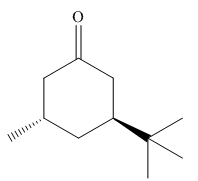
In the given molecule, there is a six member cyclic structure containing carbonyl group as a part of the ring. Thus, it is cyclohexanone. It has two substituents attached which are tertiary butyl group and a methyl group at C3 and C5 carbon atoms of cyclohexanone. Both substituents are trans to each other, as they lie on the opposite side of the ring. The tertiary butyl group is the bulkier substituent on the ring, and it is more stable in an equatorial position. Begin by drawing a chair conformation with a tertiary butyl group in an equatorial position. It is shown by a wedge bond, hence, it must point up in the chair conformation. The tertiary butyl group is pointed up and the methyl group must point down, for them to be trans, hence, the methyl group occupies the axial position as shown below:

If the chair is flipped, the equatorial tertiary butyl group becomes axial. The chair conformation having the bulkier tertiary butyl group in axial position is not stable. Hence, the most stable chair conformation of the given molecule is:

The most stable conformation of the given molecule has one substituent at equatorial position and another at axial position.
Interpretation:
The most stable chair conformation of the given molecule is to be drawn in which a
Concept introduction:
According to VSEPR theory,
The most stable chair confirmation of disubstituted cyclohexane is the one in which the larger substituent occupies equatorial position.
In disubstituted cyclohexane, the substituents which are on the same side are cis to each other whereas substituents which are on the opposite side of the ring are trans to each other. If there is more than one substituent attached, then the conformation in which maximum substituents are in equatorial position is favored and is the most stable. Substituents that are trans to each other in one chair conformation remain trans after the chair flip, whereas substituents that are cis remain cis to each other during the ring flip.
Answer to Problem 4.70P
The most stable conformation of the given molecule is:
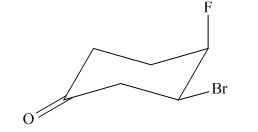
Explanation of Solution
The given molecule is:
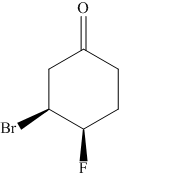
In the given molecule, there is a six member cyclic structure containing carbonyl group as a part of the ring. Thus, it is cyclohexanone. It has two substituents attached which are fluorine and bromine atoms at C3 and C4 carbon atoms of cyclohexanone. Both substituents are cis to each other, as they lie on the same side of the ring. Out of the two substituents, bromine atom is the largest substituent on the ring, and it is more stable in an equatorial position. Begin by drawing a chair conformation with bromine atom in equatorial position. It is shown by a wedge bond, hence, it must point up in the chair conformation. The bromine atom is pointed up and the fluorine atom must also point up for them to be cis, hence the fluorine atom occupies an axial position as shown below:

If the chair is flipped, the equatorial bromine atom becomes axial. The chair conformation having the bulkier group in equatorial position is more stable. Hence, the most stable chair conformation of the given molecule is:

The most stable conformation of the given molecule has one substituent at equatorial position and another at axial position.
(c)
Interpretation:
The most stable conformation of the given molecule is to be drawn.
Concept introduction:
According to VSEPR theory,
The most stable chair confirmation of disubstituted cyclohexane is the one in which the larger substituent occupies the equatorial position.
In disubstituted cyclohexane, the substituents which are on the same side are cis to each other whereas substituents which are on the opposite side of the ring are trans to each other. If there is more than one substituent attached, then the conformation in which maximum substituents are in equatorial position is favored and is the most stable. Substituents that are trans to each other in one chair conformation remains trans after the chair flip, whereas substituents that are cis remain cis to each other during the ring flip.
Answer to Problem 4.70P
The most stable conformation of the given molecule is:
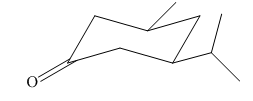
Explanation of Solution
The given molecule is:
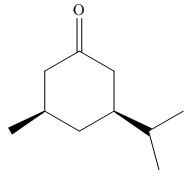
In the given molecule, there is a six member cyclic structure containing carbonyl group as a part of the ring. Thus, it is cyclohexanone. It has two substituents attached which are isopropyl group and methyl group at C3 and C5 carbon atoms of cyclohexanone. Both substituents are cis to each other as they lie on the same side of the ring. The isopropyl group is the largest substituent on the ring, and it is more stable in an equatorial position. Begin by drawing a chair conformation with isopropyl group in the equatorial position. It is shown by a wedge bond, hence, it must point up in the chair conformation. The isopropyl group is pointed up and the methyl group must also point up for them to be cis hence the methyl group goes to another equatorial position as shown below:

If the chair is flipped, both equatorial groups become axial. The chair conformation having the bulkier group in equatorial position is more stable. Hence, the most stable chair conformation of the given molecule is:

The most stable conformation of the given molecule has both substituents in equatorial position.
(d)
Interpretation:
The most stable conformation of the given molecule is to be drawn.
Concept introduction:
According to VSEPR theory,
The most stable chair confirmation of disubstituted cyclohexane is the one in which the larger substituent occupies the equatorial position.
In disubstituted cyclohexane, the substituents which are on the same side are cis to each other whereas substituents which are on the opposite side of the ring are trans to each other. If there is more than one substituent attached, then the conformation in which maximum substituents are in equatorial position is favored and is the most stable. Substituents that are trans to each other in one chair conformation remain trans after the chair flip, whereas substituents that are cis remain cis to each other during the ring flip.
Answer to Problem 4.70P
The most stable conformation of the given molecule is:
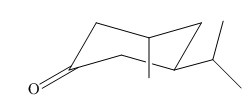
Explanation of Solution
The given molecule is:
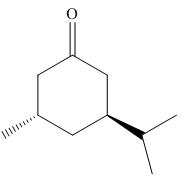
In the given molecule, there is a six member cyclic structure containing carbonyl group as a part of the ring. Thus, it is cyclohexanone. It has two substituents attached which are fluorine and bromine atoms at C3 and C4 carbon atoms of cyclohexanone. Both substituents are trans to each other, as they lie on the opposite side of the ring. Out of the two substituents, the isopropyl group is the largest substituent on the ring, and it is more stable in an equatorial position. Begin by drawing a chair conformation with isopropyl group in equatorial position. It is shown by a wedge bond, hence, it must point up in the chair conformation. The isopropyl group is pointed up and the methyl group must point down for them to be trans, hence the methyl group goes to axial position as shown below:

If the chair is flipped, the equatorial Isopropyl group becomes axial. The chair conformation having the bulkier group in equatorial position is more stable. Hence, the most stable chair conformation of the given molecule is:

The most stable conformation of the given molecule has one substituent at equatorial position and another at axial position.
(e)
Interpretation:
The most stable conformation of the given molecule is to be drawn.
Concept introduction:
According to VSEPR theory,
The most stable chair confirmation of disubstituted cyclohexane is the one in which the larger substituent occupies the equatorial position.
In disubstituted cyclohexane, the substituents which are on the same side are cis to each other whereas substituents which are on the opposite side of the ring are trans to each other. If there is more than one substituent attached, then the conformation in which maximum substituents are in equatorial position is favored and is the most stable. Substituents that are trans to each other in one chair conformation remain trans after the chair flip, whereas substituents that are cis remain cis to each other during the ring flip.
Answer to Problem 4.70P
The most stable conformation of the given molecule is:
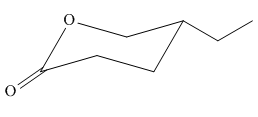
Explanation of Solution
The given molecule is:
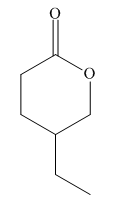
In the given molecule, there is a six membered cyclic structure containing ester group as a part of the ring. It has one substituent attached which is a ethyl group not shown by a wedge or dash bond. Thus, the ethyl group can be placed above or below the plane of the ring. The ethyl group is more stable at equatorial position than axial position. Thus, the most stable chair conformation of the given molecule is:

The most stable chair conformation of the given molecule has the bulkier substituent at equatorial position.
Want to see more full solutions like this?
Chapter 4 Solutions
Get Ready for Organic Chemistry
- Predict the major products of this organic reaction: 1. LDA (-78°C) ? 2. Br Some notes: • Draw only the major product, or products. You can draw them in any arrangement you like. . • Be sure to use wedge and dash bonds where necessary, for example to distinguish between major products that are enantiomers. • If there are no products, just check the box under the drawing area. No reaction. Click and drag to start drawing a structure. Xarrow_forwardPlease draw the structuresarrow_forwardDraw the missing intermediates 1 and 2, plus the final product 3, of this synthesis: 0 1. Eto 1. Eto- 1 2 2. MeBr 2. EtBr H3O+ A 3 You can draw the three structures in any arrangement you like. Explanation Check Click and drag to start drawing a structure.arrow_forward
- Draw the missing intermediate 1 and final product 2 of this synthesis: 1. MeO- H3O+ 1 2 2. PrBr Δ You can draw the two structures in any arrangement you like. Click and drag to start drawing a structure.arrow_forwardWhat is the differences between: Glyceride and phosphoglyceride Wax and Fat Soap and Fatty acid HDL and LDL cholesterol Phospho lipids and sphingosine What are the types of lipids? What are the main lipid components of membrane structures? How could lipids play important rules as signaling molecules and building units? The structure variety of lipids makes them to play significant rules in our body, conclude breifly on this statement.arrow_forwardWhat is the differences between DNA and RNA for the following: - structure - function - type What is the meaning of: - replication - transcription - translation show the base pair connection(hydrogen bond) in DNA and RNAarrow_forward
- What is the IP for a amino acid- give an example what are the types of amino acids What are the structures of proteins The N-Terminal analysis by the Edman method shows saralasin contains sarcosine at the N-terminus. Partial hydrolysis of saralasin with dilute hydrochloric acid yields the following fragments: Try-Val-His Sar-Arg-Val His-Pro-Ala Val- Tyr- Val Arg-Val-Tyr What is the structure of saralasin?arrow_forwardWhat is the IP for a amino acid- give an example what are the types of amino acids What are the structures of proteins The N-Terminal analysis by the Edman method shows saralasin contains sarcosine at the N-terminus. Partial hydrolysis of saralasin with dilute hydrochloric acid yields the following fragments: Try-Val-His Sar-Arg-Val His-Pro-Ala Val- Tyr- Val Arg-Val-Tyr What is the structure of saralasin?arrow_forward> aw the missing intermediates 1 and 2, plus the final product 3, of this synthesis: 1. Eto 1. EtO¯ H3O+ 1 2 2. PrBr 2. PrBr Δ You can draw the three structures in any arrangement you like. 3 Click and drag to start drawing a structure. Explanation Check 2025 McGraw Hill LLC. All Rights Reserved. Terms of Use Privacarrow_forward
- There are various factors that affect an equilibrium. Give 3 of these factors and explain using examples andequations how an equilibrium is affected by these factors. Please remember that this is a communication question so that you are communicating your understanding of the factors that affect and equilibrium.arrow_forwardEEZE LETCHUP ID Draw the most likely conjugate base resulting from this acid-base reaction. Include all lone pairs. Ignore inorganic byproducts. Drawing く NaOCH2CH3 :0: :0: 狗arrow_forwardAnswerarrow_forward
 Organic Chemistry: A Guided InquiryChemistryISBN:9780618974122Author:Andrei StraumanisPublisher:Cengage Learning
Organic Chemistry: A Guided InquiryChemistryISBN:9780618974122Author:Andrei StraumanisPublisher:Cengage Learning Organic ChemistryChemistryISBN:9781305580350Author:William H. Brown, Brent L. Iverson, Eric Anslyn, Christopher S. FootePublisher:Cengage Learning
Organic ChemistryChemistryISBN:9781305580350Author:William H. Brown, Brent L. Iverson, Eric Anslyn, Christopher S. FootePublisher:Cengage Learning

